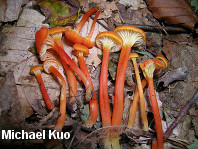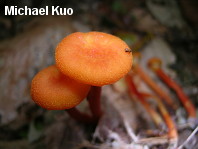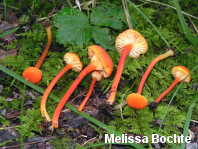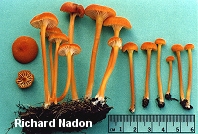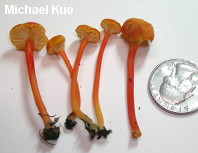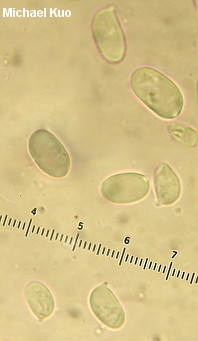| Major Groups > Gilled Mushrooms > Pale-Spored > Waxy Caps > Hygrocybe cantharellus |

|
Hygrocybe cantharellus [ Basidiomycota > Agaricales > Hygrocybaceae > Hygrocybe . . . ] by Michael Kuo Hygrocybe cantharellus is a gorgeous little waxy cap that features fairly dry surfaces, a (proportionally) long stem, a very finely scaly cap surface, and beautifully contrasting pale yellow gills that run down the stem. Since it is recorded from diverse ecosystems on five continents (Asia, Africa, Europe, North America, and South America), it is either extremely well traveled, or (more likely, in my opinion) actually a group of closely related, morphologically similar species. Compare Hygrocybe cantharellus with Hygrocybe miniata, which has attached gills that do not run deeply down the stem, along with smaller spores--and with Hygrocybe squamulosa, which is larger and features attached gills. Description: Ecology: Precise ecological role uncertain (see Lodge and collaborators, 2013); appearing in woods under hardwoods; growing gregariously or in loose troops; summer and fall; widely distributed east of the Great Plains. The illustrated and described collections are from Michigan, Pennsylvania, and Québec. Cap: 6-20 mm across; broadly convex, with an inrolled and finely scalloped margin; dry or slightly tacky, but not slimy; bald or very finely fibrillose at first; when young scarlet to reddish orange, with a yellowish margin; fading to orange or pale orange. Gills: Running down the stem; nearly distant; thick; pale yellow; short-gills present. Stem: 30-70 mm long; 2-4 mm thick; equal; dry or slightly tacky; bald; scarlet to reddish orange, with a yellowish base. Flesh: Yellowish to orangish; firm. Odor and Taste: Not distinctive. Chemical Reactions: KOH negative on cap surface. Spore Print: White. Microscopic Features: Spores 9-12 x 5-6 µ; smooth; ellipsoid or subcylindric, but only occasionally constricted; hyaline in KOH; inamyloid. Basidia 4-sterigmate; 35-45 µ long. Hymenial cystidia absent. Lamellar trama parallel. Pileipellis a trichoderm of hyaline elements; terminal elements cylindric to subfusiform. REFERENCES: (Schweinitz, 1822) Murrill, 1911. (Hesler and Smith, 1963; Smith, Smith & Weber, 1979; Phillips, 1991/2005; Lincoff, 1992; Metzler & Metzler, 1992; Arnolds, 1995; Barron, 1999; Boertmann, 2000; Roody, 2003; McNeil, 2006; Miller & Miller, 2006; Lodge et al., 2013; Kuo & Methven, 2014.) Herb. Kuo 09111011. This website contains no information about the edibility or toxicity of mushrooms. |
© MushroomExpert.Com |
|
Cite this page as: Kuo, M. (2014, July). Hygrocybe cantharellus. Retrieved from the MushroomExpert.Com Web site: http://www.mushroomexpert.com/hygrocybe_cantharellus.html |
